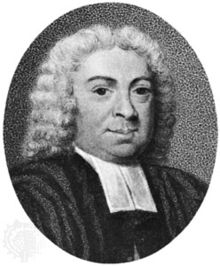Dill.
| Johann Jacob Dillenius | |
|---|---|

Johann Jacob Dillenius
|
|
| Born | 1684 Darmstadt, Hesse-Darmstadt |
| Died | 2 April 1747 Oxford, England |
| Nationality | German |
| Fields | |
| Institutions | Oxford University |
| Alma mater | University of Giessen |
| Author abbrev. (botany) | Dill. |
Johann Jacob Dillen Dillenius (1684–2 April 1747) was a German botanist.
Dillenius was born at Darmstadt and was educated at the University of Giessen, earlier the family name had been changed from Dillen to Dillenius. In 1721, at the instance of the botanist William Sherard, he moved to England. In 1734 Dillenius was appointed Sherardian professor of botany at Oxford, in accordance with the will of Sherard, who at his death in 1728 left the university £3000 for the endowment of the chair, as well as his library and herbarium, all on the condition that Dillenius should be appointed the first professor.
Dillenius died at Oxford, of apoplexy. His manuscripts, books and collections of dried plants, with many drawings, were bought by his successor at Oxford, Dr. Humphry Sibthorp (1713–1797), and ultimately passed into the possession of Oxford University. For an account of his collections preserved at Oxford, see The Dillenian Herbaria, by G. Claridge Druce (Oxford, 1907).
At Giessen Dillenius wrote botanical papers for the Ephemerides naturae curiosorum. He printed, in 1719, his flora of the University's surroundings, a Catalogus plantarum sponte circa Gissam nascentium, which was illustrated with figures drawn and engraved by his own hand, and contained descriptions of new species.
In 1724 Dillenius published the third edition of John Ray's Synopsis Methodica Stirpium Britannicarum. It incorporated plant species discovered by Samuel Brewer, and work on mosses by Adam Buddle. It remained a standard reference for British botanists until the appearance of Linnaeus' Species plantarum in 1761.
In 1732 he published Hortus Elthamensis, a catalogue of the rare plants growing at Eltham, London, in the collection of Sherard's younger brother, James (1666—1738), who, after making a fortune as an apothecary, devoted himself to gardening and music. For this work Dillenius himself executed 324 plates; it was described by Linnaeus, who spent a month with him at Oxford in 1736, and afterwards dedicated his Critica Botanica to him, as opus botanicum quo absolutius mundus non vidit, "a botanical work of which the world has not seen one more authoritative". Further, Linnaeus would later name a genus of tropical tree Dillenia in his honor.
...
Wikipedia
